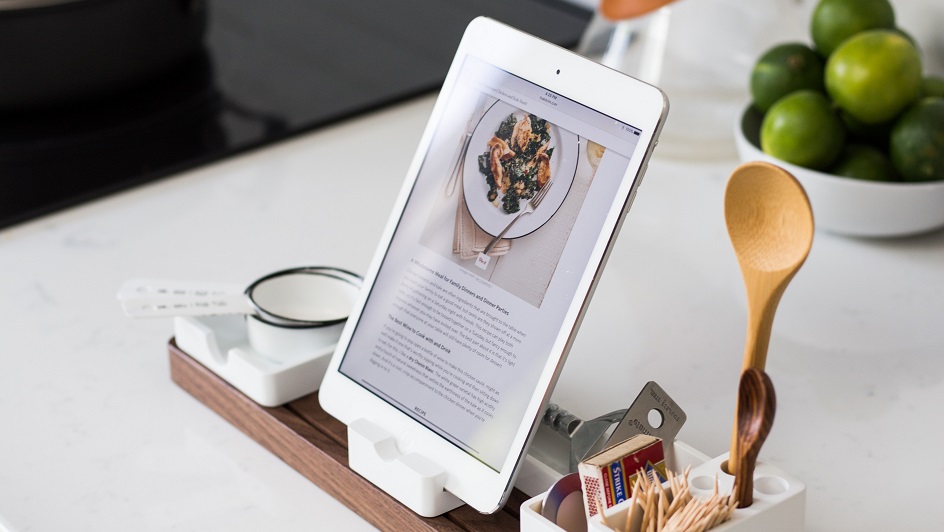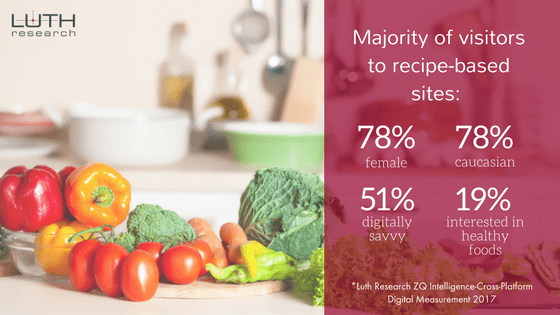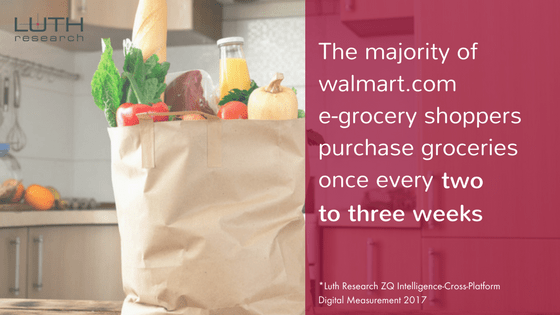
As any marketer for food brands knows, grocery e-commerce is taking off. It was big news when Amazon recently acquired Whole Foods, a move to compete with Walmart. It marks an important shift in the grocery sector, where grocery retailers can no longer rely on either brick-and-mortar stores or e-commerce, but need both.
Grocery shopping is moving online. A quarter of American households buy some of their groceries online today. And, although the market share of online grocery purchases is still small today — hovering in the low single digits — it is expected to rise to 20% by 2025.
Yesterday’s food marketers spent their time considering where best to position their food on store shelves to increase sales. To stay competitive, today’s food marketer needs to consider how products get into customers’ online grocery carts.
Interestingly, our research shows that those who shop for groceries online spend a fair amount of time on recipe websites. Even more interesting, they spend time on these recipe websites immediately before they make an e-commerce purchase.
This means online recipes can be a powerful tool in the food marketer’s arsenal. Here’s what the research shows about online grocery shopping, and several ways to use recipes in your marketing.
What the research shows about online grocery shoppers
We conducted a survey of more than 300 people to analyze the behavior of a typical consumer interested in purchasing groceries online. Respondents included those who had purchased groceries online in the previous six months, as well as those who had not done so but who were open to purchasing groceries online in the next six months. The inclusion of the latter group was intentional, as it is the most likely group to be persuaded to purchase groceries online.
For online grocery sites, we learned:
- 59% of all those who purchased groceries online were women
- 68% of those who purchased groceries on Amazon were women
- The majority of online grocery purchasers were between the ages of 35 and 54
- Instacart, Netgrocer, Peapod, and Google Shopping Express attracted a younger and more male demographic than average
For recipe sites, we learned:
- 78% of those who visited recipe sites were women
- 78% of those who visited recipe sites were Caucasian
- 51% of those who visited recipe sites were digitally-savvy
- 19%, a significant minority, of those who visited recipe sites were interested in healthy foods
- Unlike those who visited Target, Walmart, and Amazon’s websites, visitors of recipe sites stayed online long after visiting the recipe site, often to visit social media sites
This last point is particularly important. It shows that recipe sites are not endpoints; rather, they are often the beginning of activity on social media sites (Pinterest being an important place that people share recipes) and general online shopping.
Impact of recipes
The data shows that online recipes influence what people purchase online. But in case the data isn’t enough for you, here’s a strong case study.
On October 27, 2012, all of Italy sat down for the same meal: risotto with cheese and pepper. In their efforts to promote Parmigiano-Reggiano products and food from the Parma region, Parmigiano-Reggiano promoters used social media and other marketing methods to encourage people throughout Italy to eat the same meal at the same time. A world-famous Italian chef developed the inventive risotto recipe for the meal, which called for arborio rice, four kinds of pepper, and yes, Parmigiano-Reggiano.
The idea was to have a virtual, national dinner across the country — and it worked. Forbes called the event “the biggest Italian dinner in history.”
It’s an incredible testament to the power of one recipe and a marketing plan, and enough to make any food marketer’s mouth water.
How to include recipes in your marketing
Getting an entire country to use your recipe is a wonderful way of marketing your food product, but there are many other ways to use recipes in your marketing, to suit different marketing budgets and reach different audiences.
Sponsor food blogger posts
While big recipe sites like allrecipes.com get lots of traffic, many food bloggers are highly influential. Many bloggers have specific niches and loyal followings within those niches. Some focus on a particular type of cuisine (Asian, Italian, etc.), others on particular diets (vegetarian, calorie-conscious), and still others target budget-minded consumers.
Find the bloggers who share recipes that align with your products. Many will be open to writing sponsored posts. The fee for such posts varies depending on the traffic to the site.
Share recipes on social media
Whether the recipes are coming from sponsored posts or from your test kitchen, share links to them on social media. You can also share customer recipes using your product as an ingredient (though be sure to give the customer the credit).
Note that you must observe copyright law. Unless a recipe has come straight from your test kitchen, do not share the entire recipe on social media. Simply share a link from the original source and always give credit to the person who developed the recipe.
Other good rules of thumb when sharing recipes on social media:
- Share great photos. Great photos get likes and shares. If a food photo isn’t great, then it won’t get the same traction.
- Use the social media sites your target market uses. Pinterest is great for sharing recipes and photos, but, for example, if you’re targeting men, there may be better channels. Research which social channels your audience uses, and then build your presence there.
Produce your own magazine
Glossy magazines with gorgeous photos of food and recipes are a great way of getting your recipes out there, especially for a less digitally-savvy audience that still relies on hard copies of recipes.
Take a look at the Liquor Control Board of Ontario’s immensely successful magazine, Food & Drink. It’s a great example of how a magazine can promote your products. Wegmans also has a quarterly magazine that promotes its products.
As grocery shoppers move online, make sure you move online, too. Using recipes in your marketing can help your product become top of mind when customers are filling their online carts.
Whether you get the entire country to use your recipe, or rely on sponsored posts, social media, or your own magazine (or all of the above), you’ll be making it more likely online shoppers choose your products at the checkout.
Image source: Jeff Sheldon


